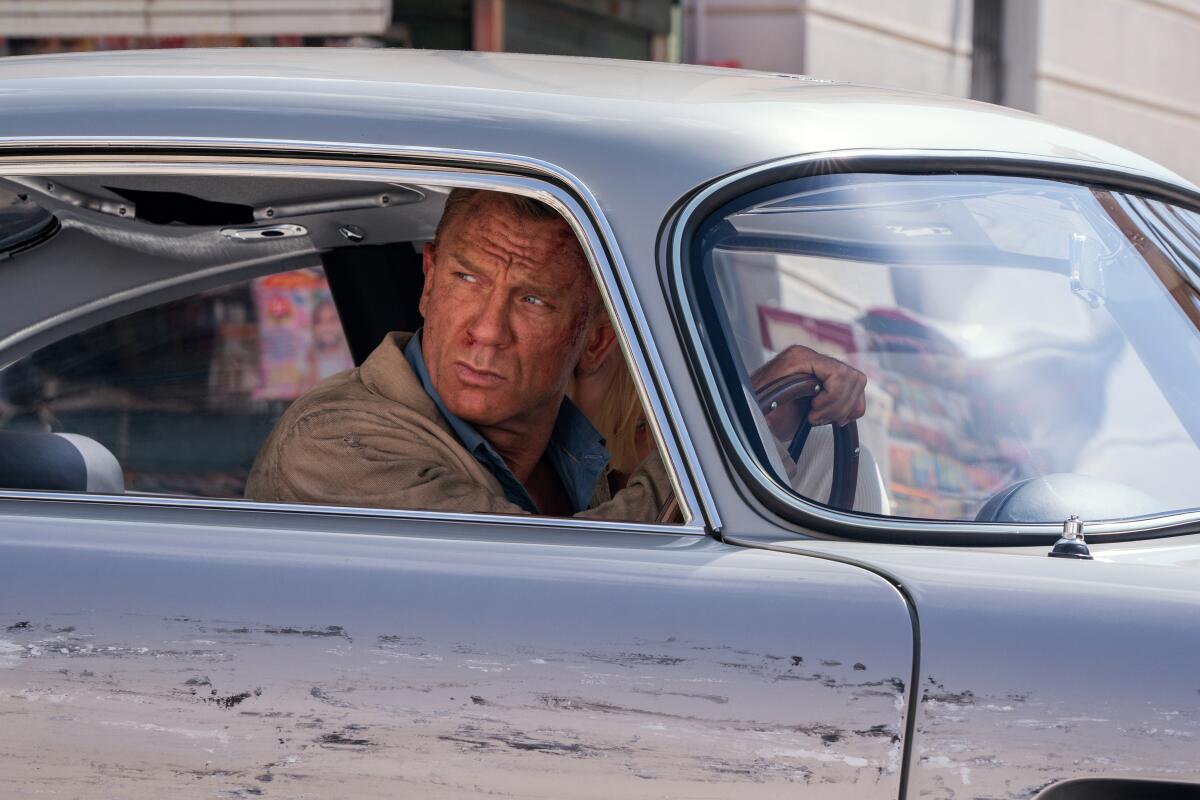Elaborate stunts and high-speed visuals go with the job on a Bond movie

- Share via
From a thrilling opening sequence shot on a frozen lake in Norway to a white-knuckle Aston Martin DB5 shootout in Matera, Italy, “No Time to Die” is packed with complicated sequences that required close collaboration between the film’s practical effects unit and the digital VFX departments. Not surprisingly, the movie, directed by Cary Joji Fukunaga, was nominated for a visual effects Oscar.
“This is the first time a James Bond movie has received the VFX Oscar nomination in 43 years,” says production special effects supervisor Chris Corbould, who has worked on 15 Bond movies since 1977’s “The Spy Who Loved Me.” “I think what was groundbreaking was that the storyline, characters and the emotionally powerful scenes in the film were all at a place where we had never been before.”
Corbould, who won an Oscar for his work on Christopher Nolan’s 2010 feature “Inception,” says the sequence he’s proudest of is the one featuring a sinking trawler carrying Bond (Daniel Craig) and Felix Leiter (Jeffrey Wright). The elaborate scene includes some footage shot off Port Antonia, Jamaica, and a 50-foot-long mechanical rig that could rotate 360 degrees and then sink into 20 feet of water back in the U.K.’s Pinewood Studios.
Visual effects supervisor Charlie Noble, who oversaw almost 1,500 shots created by DNEG, ILM, Cinesite, Lola and several other VFX companies for the film, breaks it down. “The real trawler was shot in Port Antonia, which gave us the chance to scan and texture it. Then we built a CG version of that for the exterior underwater sinking shots, which required massive simulations for the water, the bubbles, the oil that’s leaking out and all the detritus that’s lifting off the deck as it goes down, as well as all the volumetric lighting. We took that version below the waves and amped it up a bit because red light doesn’t travel that far in water. That was a monumental effort by the team at DNEG, which had to turn that scene around in only about nine weeks.”
The film’s opening flashback scene, which was shot on a frozen lake about two hours to the west of Oslo, was another challenging assignment for the effects team. “Chris surrounded the whole place with his smoke trucks, some of them over a mile away, which gave us a beautiful blanket of [atmospheric visuals] surrounding our set,” says Noble. “Our director wanted a specific look for the ice itself — it had to be thick, very clear steel ice, which was riven with cracks and frozen water bubbles. We tried to polish the top layer of crud off of it and get down to the beautiful clear ice. We had variable lighting, weather and wind conditions during the course of the week, so we had to take what Chris had done [in camera] and based our work on a couple of [the scenes Fukunaga shot] that Cary really loved.”
James Bond will return, but Daniel Craig won’t. How well did the series send him off? Two critics debate the spoiler-filled finer points.
Another labor-intensive scene involved Bond (Craig) and Madeleine (Léa Seydoux) getting attacked by gunmen as they are caught inside a classic Aston Martin DB5 in the middle of an Italian town square. “To see the Aston Martin DB5 coming back into full action mode was a real thrill: The car had had a few cameo roles over the last few years but not since ‘Goldfinger’ has it been in full action,” says Corbould.
“We had 10 Aston Martins doing various things, including two real ones and two with driving pods on the roof so we could have three-time British driving champion Mark Higgins driving through the roof with Daniel and Léa inside experiencing the G-force and giving us the facial reactions that you get when you are driving 70 miles an hour and skidding around corners.”
The art department also added concrete barriers along the street and camouflaged them as part of the historical buildings to protect them from the car cornering at a super high speed. “Matera is thousands of years old, so we had to be respectful of all the architecture,” Corbould says. “There’s an 800-year-old church there, and everything you see from three foot down are the panels that we built so we could have the pyrotechnics embedded in the scene. It was a powerful, gritty sequence and we are so grateful to the townsfolk of Matera for allowing us to shut down the main road while we shot it.”
Both Noble and Corbould were very pleased that the film was shot in Imax and was able to play in theaters around the world after the release date was pushed back several times. “The whole Matera scene was shot in Imax and it would have been absolutely criminal if it hadn’t been shown on the big screen,” says Corbould. “The producers fought tooth and nail to make sure the film was seen the way it was supposed to be in theaters. Of course, Daniel Craig was absolutely on fire with his acting. I’ve witnessed him grow so much through the years, and to see this final, powerful performance was absolutely astounding and quite moving.”
More to Read
Sign up for The Envelope
Get exclusive awards season news, in-depth interviews and columnist Glenn Whipp’s must-read analysis straight to your inbox.
You may occasionally receive promotional content from the Los Angeles Times.






